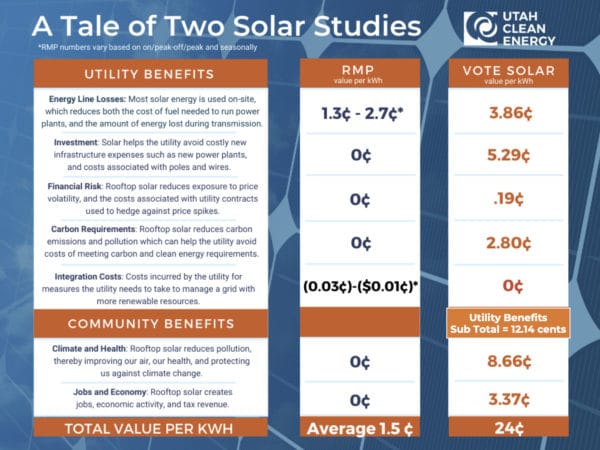A crucial hearing is scheduled to start this week at the Utah Public Service Commission that could decide the future of rooftop solar in the state — yes, it’s the Solar Export Credit Proceeding.
Rocky Mountain Power (RMP) currently pays an average of 9.2¢/kWh for exported solar, and the utility is proposing that it pay an average price of 1.5¢/kWh for new customers starting in 2021, an 84% reduction. RMP is also asking for a one-time $150 application fee and a $160 customer generation meter fee.
Vote Solar argues that the actual value is 22.6¢/kWh, but has called on regulators to abandon this rate structure entirely and move back to net metering.
Since the first net metering law was passed in Minnesota in 1983, grid-tied customers exporting power to the grid expect to be compensated “at the average retail utility energy rate.” And since that day 37 years ago, utilities across the land have challenged the value that distributed rooftop solar provides to the grid.
A make or break moment
“Determining solar rates is a complex thing,” according to Kate Bowman at Utah Clean Energy, who said this proceeding was “a make or break moment,” during a webinar last week. She contended that RMP’s assessment of solar’s value was narrow and based on fuel costs.
She said a rate reduction would “sends a signal to customers that their investment is worthless” with no savings over 25 years. She said her organization was calculating a fair value for solar energy by “examining all the benefits solar provides.” She added that less than 2% of Utah’s energy comes from residential solar.
In that same webinar, Joshua Neves, general counsel at Utah’s Blue Raven Solar, said that Blue Raven Solar was forced to shift many of its operations to others states as a result of the last rate reduction in 2017. The RMP proposal will “move solar out of reach for many Utahns,” according to Neves — and a sudden, precipitous drop in export rates would mean “most of the solar companies doing business in Utah would disappear overnight.”
Neves added, “The current Rocky Mountain Power proposal will easily be the most regressive rate restructure in the country and…will literally eliminate thousands of jobs here in Utah.”
New rooftop solar installations in Utah went from 4,140 in 2016 to 12,408 in 2017 before falling to 3,540 last year, in response to cutting the state’s net metering program, according to the Utah Solar Energy Association. There are approximately 7,000 people employed in the solar industry in Utah today.
Sachu Constantine said that Vote Solar “takes an expansive view of the value of solar” with an extensive analysis of benefit streams and analysis based on best practices in other states. Vote Solar improved the sample size of its study compared to RMP’s and looked at energy line losses, T&D deferment, financial risk and carbon impacts. Benefits include reduced power plant emissions and the avoided costs of purchasing fuel to run those power plants.
Constantine said, “Integration costs for the utility at this penetration is de minimis.” He added that climate and health has a value.
Vote Solar’s recommendation is to simply return to the retail rate, citing studies from Gridlab that show that a portfolio including distributed solar is actually a lower cost portfolio than one that relies solely on utility scale solar. “We don’t want Utah to be left out of a future that doesn’t include lower rates,” said Constantine.
Rocky Mountain Power has its own ideas
Rocky Mountain Power’s proposal is based on its own survey data and the rapidly evolving economics of solar technology, according to utility spokesman Spencer Hall, quoted in the Salt Lake Tribune.
“That price is reflective of what it costs us to produce and to put [solar power] out there,” Hall said. “When we do it at a utility scale, we offer other things such as maintenance on the system.”
Utah Clean Energy claims that Rocky Mountain Power “only considers a few of the benefits of solar energy.” Vote Solar calculated the value of solar to be 24 cents per kilowatt-hour – more than double the current rate of 9.2 cents. Here’s a comparison of the calculations.

The value ultimately depends on which costs and benefits are considered by the Utah Public Service Commission.
The hearing begins on September 29th and the Public Hearing is scheduled for October 5, where members of the public can weigh in with comments to the Commission.
This content is protected by copyright and may not be reused. If you want to cooperate with us and would like to reuse some of our content, please contact: editors@pv-magazine.com.







The value of solar is declining. Rocket Mountain has that basically correct! The missed oppertunity is not bringing the bulk purchasing power of utilities to distributed solar. Buying solar equipment relal is a distortion. The utilities can put it in either side of the meter. The utility solar farms are driving costs down across the entire industry. E Musk is driving down his solar costs in a similar business plan. What this one does will depend on the battery costs in the future. Many utilities are in a legal straight jacket from a now obsolete business model. Community solar, Clubs might be a way to crack this open. The future is $0.02 KW and lower cost energy that is clean not merely renewable. If you want to electrify, and go hydrogen. This is what has to be done,